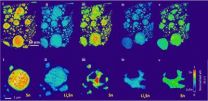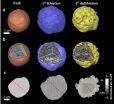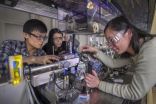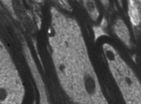(Press-News.org) UPTON, NY-Scientists at the U.S. Department of Energy's Brookhaven National Laboratory have made the first 3D observations of how the structure of a lithium-ion battery anode evolves at the nanoscale in a real battery cell as it discharges and recharges. The details of this research, described in a paper published in Angewandte Chemie, could point to new ways to engineer battery materials to increase the capacity and lifetime of rechargeable batteries.
"This work offers a direct way to look inside the electrochemical reaction of batteries at the nanoscale to better understand the mechanism of structural degradation that occurs during a battery's charge/discharge cycles," said Brookhaven physicist Jun Wang, who led the research. "These findings can be used to guide the engineering and processing of advanced electrode materials and improve theoretical simulations with accurate 3D parameters."
Chemical reactions in which lithium ions move from a negatively charged electrode to a positive one are what carry electric current from a lithium-ion battery to power devices such as laptops and cell phones. When an external current is applied-say, by plugging the device into an outlet-the reaction runs in reverse to recharge the battery.
Scientists have long known that repeated charging/discharging (lithiation and delithiation) introduces microstructural changes in the electrode material, particularly in some high-capacity silicon and tin-based anode materials. These microstructural changes reduce the battery's capacity-the energy the battery can store-and its cycle life-how many times the battery can be recharged over its lifetime. Understanding in detail how and when in the process the damage occurs could point to ways to avoid or minimize it.
"It has been very challenging to directly visualize the microstructural evolution and chemical composition distribution changes in 3D within electrodes when a real battery cell is going through charge and discharge," said Wang.
A team led by Vanessa Wood of the university ETH Zurich, working at the Swiss Light Source, recently performed in situ 3D tomography at micrometer scale resolution during battery cell charge and discharge cycles.
Achieving nanoscale resolution has been the ultimate goal.
"For the first time," said Wang, "we have captured the microstructural details of an operating battery anode in 3D with nanoscale resolution, using a new in-situ micro-battery-cell we developed for synchrotron x-ray nano-tomography-an invaluable tool for reaching this goal." This advance provides a powerful new source of insight into microstructural degradation.
Building a micro battery
Developing a working micro battery cell for nanoscale x-ray 3D imaging was very challenging. Common coin-cell batteries aren't small enough, plus they block the x-ray beam when it is rotated.
"The whole micro cell has to be less than one millimeter in size but with all battery components-the electrode being studied, a liquid electrolyte, and the counter electrode-supported by relatively transparent materials to allow transmission of the x-rays, and properly sealed to ensure that the cell can work normally and be stable for repeated cycling," Wang said. The paper explains in detail how Wang's team built a fully functioning battery cell with all three battery components contained within a quartz capillary measuring one millimeter in diameter.
By placing the cell in the path of high-intensity x-ray beams generated at beamline X8C of Brookhaven's National Synchrotron Light Source (NSLS), the scientists produced more than 1400 two-dimensional x-ray images of the anode material with a resolution of approximately 30 nanometers. These 2D images were later reconstructed into 3D images, much like a medical CT scan but with nanometer-scale clarity. Because the x-rays pass through the material without destroying it, the scientists were able to capture and reconstruct how the material changed over time as the cell discharged and recharged, cycle after cycle.
Using this method, the scientists revealed that, "severe microstructural changes occur during the first delithiation and subsequent second lithiation, after which the particles reach structural equilibrium with no further significant morphological changes."
Specifically, the particles making up the tin-based anode developed significant curvatures during the early charge/discharge cycles leading to high stress. "We propose that this high stress led to fracture and pulverization of the anode material during the first delithiation," Wang said. Additional concave features after the first delithiation further induced structural instability in the second lithiation, but no significant changes developed after that point.
"After these initial two cycles, the tin anode shows a stable discharge capacity and reversibility," Wang said.
"Our results suggest that the substantial microstructural changes in the electrodes during the initial electrochemical cycle-called forming in the energy storage industry-are a critical factor affecting how a battery retains much of its current capacity after it is formed," she said. "Typically a battery loses a substantial portion of its capacity during this initial forming process. Our study will improve understanding of how this happens and help us develop better controls of the forming process with the goal of improving the performance of energy storage devices."
Wang pointed out that while the current study looked specifically at a battery with tin as the anode, the electrochemical cell her team developed and the x-ray nanotomography technique can be applied to studies of other anode and cathode materials. The general methodology for monitoring structural changes in three dimensions as materials operate also launches an opportunity to monitor chemical states and phase transformations in catalysts, other types of materials for energy storage, and biological molecules.
The transmission x-ray microscope used for this study will soon move to a full-field x-ray imaging (FXI) beamline at NSLS-II, a world-class synchrotron facility now nearing completion at Brookhaven Lab. This new facility will produce x-ray beams 10,000 times brighter than those at NSLS, enabling dynamic studies of various materials as they perform their particular functions.
INFORMATION:
Jiajun Wang and Yu-chen Karen Chen-Wiegart are research associates in Wang's research group and performed the work together.
This research was funded as a Laboratory Directed Research and Development project at Brookhaven Lab and by the DOE Office of Science. The transmission x-ray microscope used in this work was built with funding from the American Recovery and Reinvestment Act.
DOE's Office of Science is the single largest supporter of basic research in the physical sciences in the United States, and is working to address some of the most pressing challenges of our time. For more information, please visit science.energy.gov.
One of ten national laboratories overseen and primarily funded by the Office of Science of the U.S. Department of Energy (DOE), Brookhaven National Laboratory conducts research in the physical, biomedical, and environmental sciences, as well as in energy technologies and national security. Brookhaven Lab also builds and operates major scientific facilities available to university, industry and government researchers. Brookhaven is operated and managed for DOE's Office of Science by Brookhaven Science Associates, a limited-liability company founded by the Research Foundation for the State University of New York on behalf of Stony Brook University, the largest academic user of Laboratory facilities, and Battelle, a nonprofit applied science and technology organization.
Related Links
Scientific paper: "In Situ Three Dimensional Synchrotron X-ray Nano-tomography of (De)lithiation Process in Sn Anodes"
http://dx.doi.org/10.1002/anie.201310402
Scientists track 3-D nanoscale changes in rechargeable battery material during operation
First 3-D nanoscale observations of microstructural degradation during battery charge-discharge cycles
2014-03-27
ELSE PRESS RELEASES FROM THIS DATE:
Dentist shortage bites California as more choose to practice out of state
2014-03-27
A lingering recession, the elimination of Medicaid dental reimbursements and a glut of established dentists in wealthier, populated areas may explain why more new dentists are practicing outside California, according to a new policy brief from the UCLA Center for Health Policy Research.
"Good access to dental care depends on having a robust supply of new dentists in California," said Nadereh Pourat, director of research at the center and lead author of the study. "We need a new generation of dentists to replace the many dentists who are close to retirement." ...
Decline of natural history troubling for science, society
2014-03-27
Support for natural history – the study of organisms, how and where they live and how they interact with their environment – appears to be in steep decline in developed countries, according to Joshua Tewksbury, a University of Washington professor and WWF International scientist.
"Yet natural history provides essential knowledge for fields as varied as human health, food security, conservation, land management and recreation," he said.
Tewksbury and 16 other scientists from across North America outline the importance to society and call for a revitalization of the practice ...
Big data keeps complex production running smoothly
2014-03-27
Large amounts of data are produced when industrial companies monitor their facilities. Sensors check temperature, pressure, power, or energy use data. "If you're scanning to the nearest second, it's easy to rack up several terabytes of information in under a week," says Dr. Olaf Sauer from the automation business unit at the IOSB. But often there is a lack of suitable methods to evaluate the information. "Today's operators use only about seven percent of this data for maintenance or protection from breakdowns," adds Sauer. At the Hannover Messe Digital Factory, IOSB developers ...
One size does not fit all: Dietary guidelines for choline may be insufficient
2014-03-27
What is now considered to be the "right" amount of the essential nutrient, choline, might actually be "wrong," depending on who you are. That's because scientists have found that the "right" amount of choline needed by an individual is influenced by a wide range of factors, including gender, life stage, race and ethnicity of the individual. This means that using the current one-size-fits-all approach to determining a person's vitamin and mineral needs may leave them in less than optimal health. Choline is an essential nutrient used by the body to construct cell membranes ...
First sightings of solar flare phenomena confirm 3D models of space weather
2014-03-27
Scientists have for the first time witnessed the mechanism behind explosive energy releases in the Sun's atmosphere, confirming new theories about how solar flares are created.
New footage put together by an international team led by University of Cambridge researchers shows how entangled magnetic field lines looping from the Sun's surface slip around each other and lead to an eruption 35 times the size of the Earth and an explosive release of magnetic energy into space.
The discoveries of a gigantic energy build-up bring us a step closer to predicting when and where ...
Military men more distressed by sexual harassment than military women, research finds
2014-03-27
WASHINGTON – Military men who are targets of frightening and threatening sexual harassment may experience more distress and work performance problems than military women who face the same treatment, according to research published by the American Psychological Association.
A total of 52 percent of military women said they had been sexually harassed compared with 19 percent of military men, and women more frequently reported they were very frightened by the experience than their male colleagues, according to a study published online in APA's Journal of Occupational Health ...
Gen X obesity a major problem for healthcare, workforce
2014-03-27
Researchers at the University of Adelaide have confirmed that if current trends continue, Australia's Generation X will overtake Baby Boomers for poor health, including rates of obesity and diabetes, which could have huge implications for healthcare and the workforce.
In a paper published in the online journal PLOS ONE, University of Adelaide researchers compared the health status of Baby Boomers (born from 1946–1965) and Generation X (1966–1980) at the same age range of 25-44 years.
They found Generation X had significantly poorer levels of self-rated health, and higher ...
Kaixin Jieyu Fang for treatment of vascular depression
2014-03-27
The Chinese compound Kaixin Jieyu Fang can be used to treat vascular depression; however, the underlying mechanism remains unclear. Dr. Ying Zhang and co-workers from Guang'anmen Hospital, China Academy of Chinese Medical Sciences in China This study established a rat model of chronic cerebral ischemia-caused white matter damage by ligation of the bilateral common carotid arteries. Rats received daily intragastric administration of a suspension of Kaixin Jieyu Fang powder. Kaixin Jieyu Fang was made from two prescriptions of Kaixin San and Sini San supplemented with Radix ...
Despatch from the field
2014-03-27
Researchers and the public can now have immediate access to data underlying discovery of new species of life on Earth, under a new streamlined system linking taxonomic research with open data publication.
The partnership paves the way for unlocking and preserving a wealth of 'small data' backing up research conclusions, which often become lost within a few years of an article's publication in an academic journal.
In the first example of the new collaboration in action, the Biodiversity Data Journal carries a peer-reviewed description of a new species of spider discovered ...
Acupuncture enhances antidepressant effect of Seroxat
2014-03-27
Acupuncture is more effective than oral antidepressants in improving depressive symptoms, and produces fewer side effects than tricyclic antidepressants. Despite the continued development of antidepressants and alternative/synergistic therapies, major depressive disorder has not been comprehensively recognized and treatment outcome is often insufficient. An epidemiological study addressing depression showed that poor recognition and treatment are largely linked to the lack of an accurate assessment tool and to patients' economic situation. Prof. Yong Huang and team from ...
LAST 30 PRESS RELEASES:
Numbers in our sights affect how we perceive space
SIMJ announces global collaborative book project in commemoration of its 75th anniversary
Air pollution exposure and birth weight
Obstructive sleep apnea risk and mental health conditions among older adults
How talking slows eye movements behind the wheel
The Ceramic Society of Japan’s Oxoate Ceramics Research Association launches new international book project
Heart-brain connection: international study reveals the role of the vagus nerve in keeping the heart young
Researchers identify Rb1 as a predictive biomarker for a new therapeutic strategy in some breast cancers
Survey reveals ethical gaps slowing AI adoption in pediatric surgery
Stimulant ADHD medications work differently than thought
AI overestimates how smart people are, according to HSE economists
HSE researchers create genome-wide map of quadruplexes
Scientists boost cell "powerhouses" to burn more calories
Automatic label checking: The missing step in making reliable medical AI
Low daily alcohol intake linked to 50% heightened mouth cancer risk in India
American Meteorological Society announces Rick Spinrad as 2026 President-Elect
Biomass-based carbon capture spotlighted in newly released global climate webinar recording
Illuminating invisible nano pollutants: advanced bioimaging tracks the full journey of emerging nanoscale contaminants in living systems
How does age affect recovery from spinal cord injury?
Novel AI tool offers prognosis for patients with head and neck cancer
Fathers’ microplastic exposure tied to their children’s metabolic problems
Research validates laboratory model for studying high-grade serous ovarian cancer
SIR 2026 delivers transformative breakthroughs in minimally invasive medicine to improve patient care
Stem Cell Reports most downloaded papers of 2025 highlight the breadth and impact of stem cell research
Oxford-led study estimates NHS spends around 3% of its primary and secondary care budget on the health impacts of heat and cold in England
A researcher’s long quest leads to a smart composite breakthrough
Urban wild bees act as “microbial sensors” of city health.
New study finds where you live affects recovery after a hip fracture
Forecasting the impact of fully automated vehicle adoption on US road traffic injuries
Alcohol-related hospitalizations from 2016 to 2022
[Press-News.org] Scientists track 3-D nanoscale changes in rechargeable battery material during operationFirst 3-D nanoscale observations of microstructural degradation during battery charge-discharge cycles







